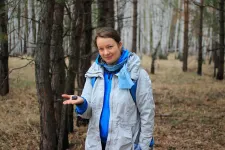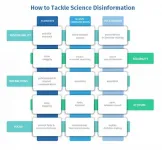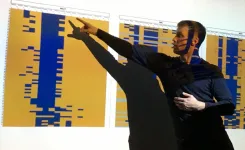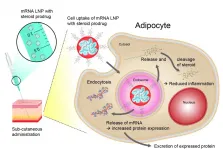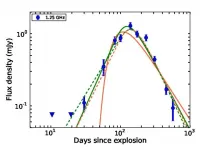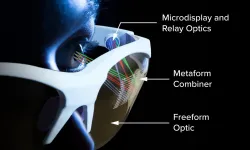INFORMATION:
Note
In 80% of cases, tsunamis are caused by seismic disturbances, as a result of which deformation (rise and fall) of the seabed occurs. The deadliest tsunami in the 21st century occurred on December 26, 2004, in the Indian Ocean, the death toll and missing persons - more than 235 thousand people. On March 11, 2011, a tsunami destroyed the Fukushima-1 nuclear power plant in Japan. The death of more than two thousand people over the next few years is associated with the disaster at the nuclear power plant.
This authors' review was based upon collaborative work within the COST Action CA18109 AGITHAR, supported by COST (European Cooperation in Science and Technology).
Scientists warn: Humanity does not have effective tools to resist the tsunami
This threatens with sudden destruction of coastal cities and numerous human casualties
2021-05-03
(Press-News.org) An international team of scientists from 20 countries identified 47 problems that hinder the successful prevention and elimination of the consequences of the tsunami. Based on the carried out analysis, the world's leading experts on natural hazards have outlined directions for further scientific research. The research group's review is published in a special issue of the "Frontiers in Earth Science".
The main problems identified in the review are related to the large gaps and uncertainties in knowledge about tsunami, the lack of well-documented observations, and imperfect methods of processing available information. One of the reasons is the lack of coordination of the efforts of those countries for which the study and prediction of tsunamis, forecasting the corresponding risks, and preparation for repelling threats are vital.
"Generally accepted approaches have not yet been determined, potentially incompatible probabilistic methods are used in different regions of the world, and different sources of tsunamis are often considered independently of each other," said authors of the research.
Maria Gritsevich, senior researcher at the Extra Terra Consortium laboratory at the Ural Federal University and at the Finnish Geospatial Research Institute, adjunct professor in planetary sciences at the University of Helsinki points out that the asteroid-comet hazard is associated with the origin of the tsunami as well.
"Science knows more than one million asteroids in the solar system," says Maria Gritsevich. "In total, according to the estimates, more than 150 million asteroids exceeding 100 meters in size revolve around the Sun. Since the ocean occupies more than 70% of the Earth's surface, collision of any of these celestial bodies with our planet may cause a strong tsunami. Let's recall that the impact of an asteroid into the Gulf of Mexico 65 million years ago led to the extinction of a large number of animal species, including dinosaurs."
The main terrestrial sources of the origin of tsunamis are abnormally strong and rapid fluctuations in atmospheric pressure, volcanic eruptions and earthquakes (on land and underwater), crustal movement, and landslides. Often these forces are interconnected. However, humanity does not have reliable historical and detailed modern data to take into account the interdependence of these factors. This leads to a difficulty to predict the time and place of each next tsunami.
Moreover, due to the uncertainties, scientists studying the natural phenomena that cause tsunamis often ignore this connection. Although tsunamis can be even more destructive and deadly. According to the authors of the review, this approach is typical, for example, for volcanologists. As a result, systematic analysis of information about tsunamis in volcano studies is often omitted the authors of the review state. In addition, the power of computer technologies used to predict tsunamis is insufficient to meet the challenges. The numerical models themselves are too complex and costly.
Due to a combination of reasons, many coastal cities, especially in developing countries, are not ready to "receive" the tsunami, to adequately assess the possible damage and losses. This is reflected, for example, in the construction of buildings and structures. Schools and hospitals, industrial enterprises, harbors, roads and bridges, power plants (including atomic ones), gas and oil storage facilities, and various communications are under the threat of destruction. And most importantly, so are the lives of many people.
"Buildings are often used as evacuation shelters," says the authors of the review. "Tsunamis affect the lower floors of a high-rise building, while seismic loads affect the upper ones. But tsunami effects such as basement erosion and debris impact are rarely modeled. These effects remain to be investigated."
Thus, there is no clear idea about the potential economic damage and costs required to combat tsunamis and their consequences. The quality of disaster risk management - who and what, from what harm, at what cost, and how to protect - often leaves much to be desired. In most cases, assistance arrives late, leaving affected communities in a vulnerable position, especially in the first hours and days after the event, states the authors' review.
"We call for the creation and continuous enrichment of unified databases, for conduction of the necessary research and regular exchange of information, for improving the methods of analysis and modeling, and careful planning of actions in case of cascading natural disasters," says Maria Gritsevich. "We are convinced that with proper funding, with the availability of the necessary scientific equipment and technology, it is quite possible to bridge the gaps in understanding the tsunami phenomenon that we have identified."
ELSE PRESS RELEASES FROM THIS DATE:
European coordination needed to fight science disinformation, academies say
2021-05-03
Berlin, 3 May - In a new report, ALLEA, the European Federation of Academies of Sciences and Humanities, examines the potential of technical and policy measures to tackle science disinformation and calls for improved European exchange and coordination in this field.
While disinformation strategies are intoxicating public discourses in many fields, science disinformation is particularly dangerous to democratic governance and society at large. As highlighted by the ongoing pandemic, an undermining of trust in science poses a fundamental threat to political and individual decisions based on evidence and scientific knowledge.
Over ...
How to manage osteoporosis in hematologic stem cell transplant recipients
2021-05-03
Impaired bone health is among the most significant long-term consequences of hematopoietic stem cell transplantation (HSCT), a common therapy for patients with malignant and non-malignant haematological diseases.
To address this serious problem, the International Osteoporosis Foundation (IOF) expert Working Group on Cancer and Bone Disease has published a new Executive Summary of its authoritative state-of-the-art review. The review outlined the major factors affecting bone health in HSCT patients, and provided expert guidance for the monitoring, evaluation and treatment of bone loss in these patients. ...
Tailor-made therapy of multi-resistant tuberculosis
2021-05-03
Globally, tuberculosis is the most common bacterial infectious disease leading to death. The pathogen causing tuberculosis, Mycobacterium tuberculosis, has a number of peculiarities. One is that it is growing very slowly. While other typical pathogens, such as pneumococcal and pseudomonads, can already be identified by their growth in the microbiological laboratory in the first 72 hours, several weeks usually pass before tuberculosis bacteria grow in the lab. Thus it often takes one to two months before the efficacy of individual medicines can be tested.
However, these efficacy tests are essential for the effective treatment of multidrug-resistant tuberculosis (MDR-TB), which is becoming increasingly common. In these cases, the pathogen has become ...
Research with neutrons for better mRNA medicines
2021-05-03
If not before, then certainly since the first messenger RNA (mRNA) vaccines to combat the SARS CoV2 virus were approved in Germany, mRNA has become a recognized term even outside scientific circles. What is less well known is that mRNA can be used to produce much more than just vaccines. Around 50 different procedures for the treatment of diseases including cancer are already being studied in clinical trials. Scientists from the pharmaceutical company AstraZeneca, with the support of neutron researchers from Forschungszentrum Jülich, have now discovered how the subcutaneous administration of mRNA can be improved. The goal is for chronically ill ...
uGMRT reveals for the first time the patchy environment of a rare cosmic explosion
2021-05-03
Scientists from the National Centre for radio Astrophysics of the Tata Institute of Fundamental Research (NCRA-TIFR) Pune used the upgraded Giant Metrewave Radio Telescope (uGMRT) to determine that AT 2018 cow, the first of a newly discovered class of cosmic explosions, has an extremely patchy environment. Sources like AT 2018cow release an enormous amount of energy, nonetheless fade extremely rapidly. This along with their extremely blue color has led to them being called FBOTs for Fast Blue Optical Transient. This is the first observational evidence of inhomogeneous emission from an FBOT. The origins of FBOTs are still under debate, but proposed models include explosion of a massive star, collision of an accreting neutron star and ...
A new way to make AR/VR glasses
2021-05-03
"Image" is everything in the $20 billion market for AR/VR glasses. Consumers are looking for glasses that are compact and easy to wear, delivering high-quality imagery with socially acceptable optics that don't look like "bug eyes."
University of Rochester researchers at the Institute of Optics have come up with a novel technology to deliver those attributes with maximum effect. In a paper in Science Advances, they describe imprinting freeform optics with a nanophotonic optical element called "a metasurface."
The metasurface is a veritable forest of tiny, silver, nanoscale structures on a thin metallic film that conforms, in this advance, to the freeform shape of ...
Researchers promote usability for everyone, everywhere
2021-05-03
According to Michael Twidale, professor in the School of Information Sciences at the University of Illinois Urbana-Champaign, bad usability can be an irritation for everyone but "especially awful" for the underprivileged. In "Everyone Everywhere: A Distributed and Embedded Paradigm for Usability," which was recently published in the Journal of the Association for Information Science and Technology (JASIST), Twidale and coauthors David M. Nichols (University of Waikato, New Zealand) and Christopher P. Lueg (Bern University of Applied Sciences, Switzerland) present a new paradigm to address the persistence of difficulties that people have ...
As wildfires increase in severity, experts call for coordinated federal response
2021-05-03
(New York, NY) - May 3, 2021 - In advance of a wildfire season projected to be among the worst, the American Thoracic Society has released a report that calls for a unified federal response to wildfires that includes investment in research on smoke exposure and forecasting, health impacts of smoke, evaluation of interventions, and a clear and coordinated communication strategy to protect public health.
The report, Respiratory Impacts of Wildland Fire Smoke: Future Challenges and Policy Opportunities, was published online ahead of print in the Annals of the American Thoracic Society on May 3, 2021.
The report comes at a time when the U.S. is experiencing an increasing frequency of very large destructive wildfires, due to years ...
Applying UV light to common disinfectants makes them safer to use
2021-05-03
Over 400 common disinfectants currently in use could be made safer for people and the environment and could better fight the COVID-19 virus with the simple application of UVC light, a new study from the University of Waterloo shows.
Benzalkonium chloride (BAK) is the most common active ingredient in many disinfectants regularly used in hospitals, households, and food processing plants to protect against a wide range of viruses and bacteria - including all strains of SARS-CoV-2, the coronavirus that causes COVID-19 - but its toxicity means that it can't be used in high concentrations. It also means that products containing BAK are harmful to humans ...
Personalised follow-up care needed to address varying health burdens in breast cancer pts
2021-05-03
LUGANO, Switzerland, 3 May 2021 - As breast cancer becomes a largely curable disease, with more than 70% of women surviving at least 10 years after diagnosis across most of Europe thanks to early detection and treatment, (1) the quality of life after cancer has become an important aspect of the patient journey - one that may be inadequately addressed with current standards of follow-up. A study presented at the ESMO Breast Cancer 2021 Virtual Congress (2) has shown that breast cancer survivors differ widely in the burden of symptoms they experience after the end of treatment and thereby revealed an unmet need for tailored approaches to follow-up care. (3)
Lead author Kelly de Ligt ...
LAST 30 PRESS RELEASES:
University of Oklahoma researcher awarded funding to pursue AI-powered material design
Exploring how the visual system recovers following injury
Support for parents with infants at pediatric check-ups leads to better reading and math skills in elementary school
Kids’ behavioral health is a growing share of family health costs
Day & night: Cancer disrupts the brain’s natural rhythm
COVID-19 vaccination significantly reduces risk to pregnant women and baby
The role of vaccination in maternal and perinatal outcomes associated with COVID-19 in pregnancy
Mayo Clinic smartwatch system helps parents shorten and defuse children's severe tantrums early
Behavioral health spending spikes to 40% of all children’s health expenditures, nearly doubling in a decade
Digital cognitive behavioral treatment for generalized anxiety disorder
Expenditures for pediatric behavioral health care over time and estimated family financial burden
Air conditioning in nursing homes and mortality during extreme heat
The Alps to lose a record number of glaciers in the next decade
What makes a good proton conductor?
New science reporting guide published for journalists in Bulgaria
New international study reveals major survival gaps among children with cancer
New science reporting guide published for journalists in Turkey
Scientists develop a smarter mRNA therapy that knows which cells to target
Neuroanatomy-informed brain–machine hybrid intelligence for robust acoustic target detection
Eight SwRI hydrogen projects funded by ENERGYWERX
The Lundquist Institute and its start-up company Vitalex Biosciences Announces Strategic Advancement of Second-Generation fungal Vaccine VXV-01 through Phase 1 Trials under $40 Million Competitive Con
Fine particles in pollution are associated with early signs of autoimmune disease
Review article | Towards a Global Ground-Based Earth Observatory (GGBEO): Leveraging existing systems and networks
Penn and UMich create world’s smallest programmable, autonomous robots
Cleveland researchers launch first major study to address ‘hidden performance killer’ in athletes
To connect across politics, try saying what you oppose
Modulating key interaction prevents virus from entering cells
Project explores barriers to NHS career progression facing international medical graduates
Jeonbuk National University researchers explore the impact of different seasonings on the flavor perception of Doenjang soup
Two Keck Medicine of USC Hospitals named Leapfrog Top Teaching Hospitals
[Press-News.org] Scientists warn: Humanity does not have effective tools to resist the tsunamiThis threatens with sudden destruction of coastal cities and numerous human casualties
